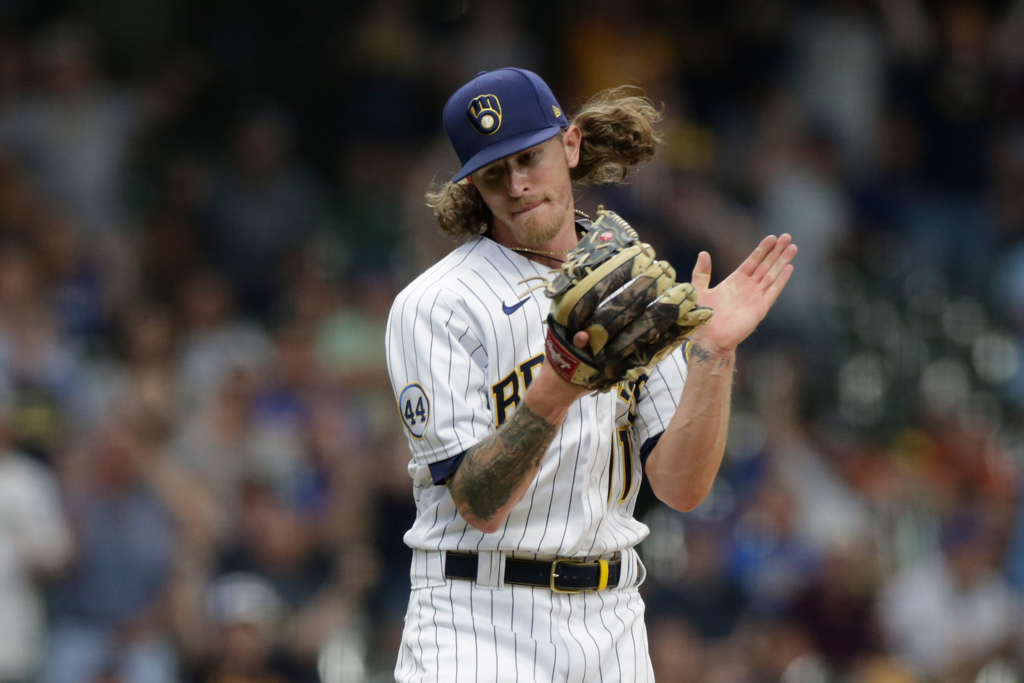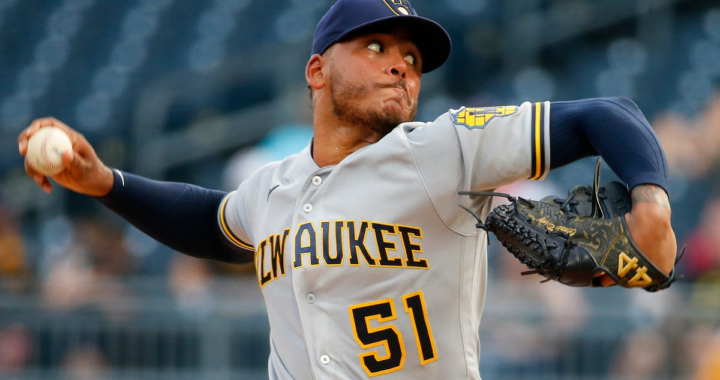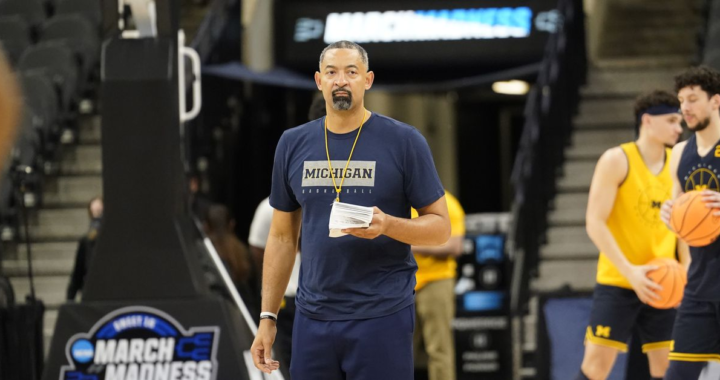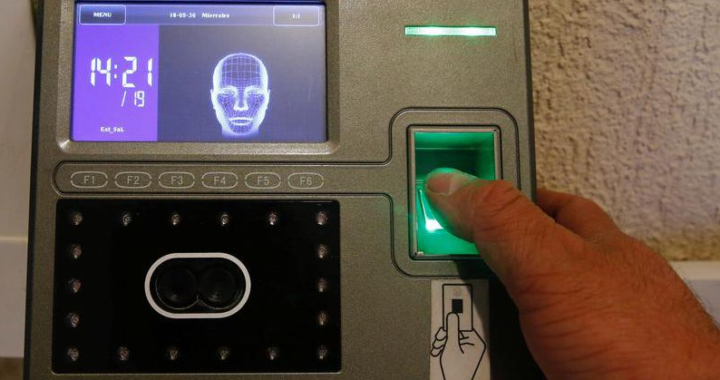Like Jacob deGrom, All-Stars Josh Hader and Craig Kimbrel Are Chasing ERA History
6 min read

John Fisher/Getty Images
Through the first half of the 2021 Major League Baseball season, all eyes have been on New York Mets ace Jacob deGrom as he seeks to break the late, great Bob Gibson’s modern ERA record of 1.12 from 1968. That effort is going well, as deGrom is at 0.95 through 14 starts.
Yet there’s also another ERA chase going on, and this one involves two All-Star closers: Milwaukee Brewers left-hander Josh Hader and Chicago Cubs right-hander Craig Kimbrel.
Through 33 appearances that span 32.2 innings, Hader’s ERA is a razor-thin 0.55. After 32 appearances and 30.2 innings of his own, Kimbrel isn’t far behind with an ERA of 0.59.
Thus are both pitchers in range of the 0.54 ERA that Zack Britton put up for the Baltimore Orioles in 2016. Though it’s debatable as to where the line should be drawn for rate stats among relief pitchers, that’s the lowest such mark for any reliever who made at least 50 appearances and/or pitched 60 innings in a single season.
There’s obviously a lot of season left, and it certainly bears mentioning that neither Hader nor Kimbrel is even on pace for a record-low ERA for a reliever just in the first half of a season. Scott Downs had a 0.30 ERA through 32 appearances for the Los Angeles Angels in the first half of 2012, and it’s perhaps a bad omen that he finished with a modest 3.15 ERA.
But from looking at how, exactly, they’re doing it, both Hader and Kimbrel seem more likely to keep going the way of Britton than to veer off in the direction of Downs.
Josh Hader, to the Max
Hader was a sensation when he first debuted for Milwaukee in 2017, and he went on to tally a 2.54 ERA with 15.3 strikeouts per nine innings between then and 2020. He was an All-Star in 2018 and 2019, and even a down-ballot Cy Young Award contender in the former season.
But while all this is basically another way of saying that 2021 isn’t Hader’s first rodeo, the 27-year-old is now tapping into something that just wasn’t there in his first four with the Brewers.
Particularly between 2018 and 2020, Hader came to have problems with home runs as he served up 27 long balls over just 176 innings. All but one of those taters were off his fastball, which generally speaks to how he was a little too prone to throwing center-cut meatballs.
Well, Hader isn’t doing that anymore as only 5.8 percent of his fastballs have found the exact middle of the strike zone in 2021. This is also an even more high-octane version of the heater he was throwing in his first four seasons. He’s averaging a career-best 96.2 mph and even hit 100 mph for the first time on Opening Day:
Factoring in how the 6’3″, 180-pounder also throws with extraordinary extension and is able to get above-average rising action on his fastball, his heater has an otherworldly nastiness just based on its tangible measurements.
So, go figure that its results are equally eye-popping. Hitters are just 5-for-61 with 31 strikeouts against it, numbers which contribute to its league-best run value on a per-100-pitch basis.
Yet now more than ever, Hader is also more than just a fastball pitcher.
He’s been keeping right-hander hitters honest by showing them occasional changeups, and he’s also throwing a slider that’s unlike the one he featured through 2020. It’s faster at an average of 83.8 mph, and with less movement both vertically and horizontally.
Though the latter might sound like a change for the worse, it’s not so bad once you see it and realize that Hader’s new slider is something like an extreme cutter:
Whereas hitters seemed to get more comfortable facing Hader after his scintillating debut in 2017, the discomfort that now marks their at-bats against him is best encapsulated in how he’s drawing swings outside the strike zone at a career-best rate of 40.1 percent.
Ultimately, Hader’s 0.55 ERA is backed up by 55 strikeouts and just 12 hits allowed even as he’s faced 121 batters. Crucially, none of those dozen hits has left the yard.
Craig Kimbrel, Resurrected
This likewise isn’t Kimbrel’s first rodeo, but you knew that. He’s literally Craig Kimbrel, in that he literally is an eight-time All-Star whose next save will move him into sole possession of ninth on the all-time list.
Kimbrel’s three seasons with the Cubs, however, has been a tale of two Kimbrels:
- First 33 G: 28.2 IP, 28 H (11 HR), 45 K, 24 BB, 7.53 ERA
- Next 40 G: 38.0 IP, 13 H (1 HR), 66 K, 10 BB, 0.47 ERA
Because the 33-year-old’s disastrous first impression as a Cub came on the heels of an unceremonious end to his three-year tenure with the Boston Red Sox, it seemed then like the veteran had exhausted his excellence.
But looking back now, it’s frankly little wonder that Kimbrel had a hard time getting in a groove. He didn’t sign with the Cubs until June 2019, and he was subsequently dogged by knee and elbow injuries. Then came 2020, in which the pandemic kept him and everyone else out of action until late July.
As for how Kimbrel has gotten his groove back, it’s helped that he’s rediscovered some lost fastball velocity. After sitting at 96.4 mph in his first 33 outings as a Cub, he’s been working at 97.1 mph since last September.
The real key, however, has been the resurgence of Kimbrel’s knuckle-curveball. It had a subpar 1.4 run value through his first 33 appearances as a Cub but has since high-tailed in the other direction to a superb minus-9.3.
As Kimbrel himself explained to MLB.com’s Jordan Bastian in April, the difference is an uncomplicated matter of location:
Jordan Bastian @MLBastian
Since Aug. 14 of last season, Craig Kimbrel has a 55.6 K%, .073 opponents’ average and .176 wOBA.<br><br>What’s been the difference?<br><br>“Throwing strikes. That’s it.”<br><br>Here is a look at his curveball location during Cubs tenure, using Aug. 14 as the dividing point. <a href=”https://t.co/7OiyUQimu5″>pic.twitter.com/7OiyUQimu5</a>
Not to be overlooked, though, is that Kimbrel has basically turned his curveball into a slider. He stills throws it hard at an average of 86.4 mph, but from a lower arm angle that has contributed to it having less vertical drop than it used to.
This is to say that Kimbrel’s hook is more so defined by its glove-side horizontal movement, which works well in tandem with the arm-side run he gets on his heater:
Though those two pitches are all Kimbrel has, he’s about as close to being unhittable as a pitcher can be. His 58.7 contact percentage is not only the lowest of the 2021 season, but also within the top 10 of the lowest contact rates on record since the early 2000s.
So if anything, Kimbrel deserves even better than the rate of 15.6 strikeouts per nine innings that currently sits next to his name.
Oh, and They’re Both Sticking to It
Once it started to become clear in May that Major League Baseball was serious about cracking down on pitchers using sticky foreign substances on the ball, some fans might have immediately thought about Kimbrel and the notorious blemish on the bill of his cap.
Sure enough, Kimbrel was confronted by umpire Joe West and was made to change his cap during a game against the Cincinnati Reds on May 28. Ever since then, his average spin rate has been down from 2,414 to 2,293 revolutions per minute.

Michael Owens/Getty Images
Within this same span, however, Kimbrel has also racked up 11 straight scoreless appearances while whiffing 18 of the 31 batters he’s faced. So in spite of his notoriously blemished cap, his non-guilty plea actually holds some water.
“I don’t use any of that stuff that they’re trying to get out of the game, anyways,” Kimbrel said in June, according to Maddie Lee of NBC Chicago.
For his part, Hader’s spin rate has also diminished from 2,129 RPM through May to 2,058 RPM since the start of June. Yet he wasn’t much of a spin rate guy to begin with, so there’s at least one reason not to read too much into that.
For good measure, here’s another: Like Kimbrel, Hader has been on a roll with 17 consecutive scoreless appearances in which he’s struck out 27 of the 60 batters he’s faced.
The short version of all this is that both Hader and Kimbrel are dominating the competition just as much as their ERAs say they are, and that they seem notably unaffected by the recent change in MLB’s attitude toward sticky stuff.
And that, of course, means their pursuit of ERA history should be taken just as seriously as deGrom’s.
Stats courtesy of Baseball Reference, FanGraphs and Baseball Savant.








